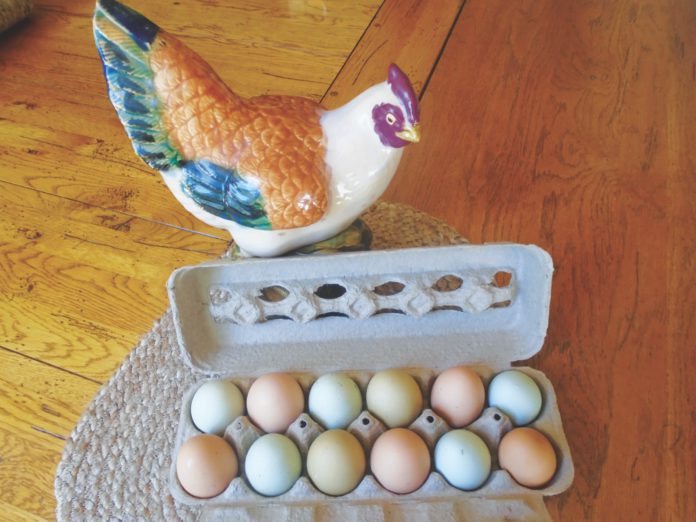“I try to take care and be gentle to them… Once broken, they become impossible to repair.” —Anne Sexton
Last week I received an email from a gentleman reader named Scott. Scott had read my cheesecake article, and Scott, a retired chef, was worried about how I handled the eggs and most importantly, at what temperature did I cook the finished cheesecake.
Once Chef Scott read my reply to his “worries,” he responded, “I was hoping I didn’t anger you and was worried about your reply to me. Your kind response to me left no doubts you know how to cook with eggs.”
Eggs are those wonderful gifts from our feathered friends of all kinds—ducks, turkeys, quail, birds and humans. All living things begin from somewhere, if not from eggs, then nature has given us seeds to produce our vegetables.
Last week, a lovely lady was delivering items for our future garage sale in support of our nonprofit organization, Damians Ladder, which provides free in-home repairs to low-income seniors and people with disabilities. As she was leaving, I was gifted a dozen lovely brown eggs from her chickens.
Now having cooked thousands of eggs in my long lifetime, I have learned along the way, of the hazard eggs can create if you are not aware of the proper way to handle eggs prior to cooking.
A little tutorial for those who might have a backyard chicken coop and unaware of the problems eggs can create.
Salmonella is caused by a bacteria in the intestines of animals, and because the eggs laid by a chicken travel through the same intestinal track as the feces, become the source of this dangerous disease. And when salmonella is known to come from fruit, especially cantaloupe, cucumbers, basil and onions, the source is generally never found, but thought to be the “food handlers” not having proper handwashing techniques.
It is known that owners of chickens, dogs, cats and yes, even turtles, often kiss these cute little creatures, resulting in 125,000 cases of salmonella a year.
Wash or not wash your eggs. No washing needed. When the egg is laid, the hen puts on a protective coating on the egg’s outside shell. Amazing! The USDA-graded eggs already have been washed and sanitized prior to being put into their carton.
When purchasing eggs, look for the “EXP” Sell By and Best if Used Before dates on the egg carton. The expiration date can be no more than 30 days from the day the eggs were packed into the carton.
Use By indicates a period the eggs should be consumed before quality diminishes. This may not exceed 45 days, including the day the eggs were put into the carton.
Bringing your eggs home from the store, put them directly in the refrigerator set at or below 40 deg. F and in their own carton, not on the door of the refrigerator.
USDA states that eggs should be cooked until both whites and yolks are firm, and scrambled eggs should be cooked to 160 deg. F. How many of us follow those rules as we ask for eggs both sunny side up or easy-over.
If your recipe calls for raw eggs, such as the 1-minute egg for a Caesar salad, purchase pasteurized eggs, which have been precooked to a low temperature. Best not to try at home; I did and was not successful. I learned it is best to leave this technique to the professionals.
The fresher your eggs are, the harder they will be to peel after hard-boiling. That’s because the air cell found at the large end of the shell between the cell membranes increases in size the longer the eggs are stored. As the egg contracts and the egg cell enlarges, the shell becomes easier to peel.
I only hard-boil one week or older eggs. I begin by placing eggs in a pot of cold water at least 2 inches above eggs. Bring to a boil and cook for 12 minutes. Turn off heat, cover and let rest for 5 minutes. Pour out water and cover eggs with ice water. When eggs are cold, I crack them against the side of my sink and peel. Works like a charm.
I love scrambled eggs, fluffy, silky, creamy, without being runny, and with a slight cheesy flavor. I have three ways of scrambling eggs, all of which depend on what I have in my fridge.
Creamy Cottage Cheese Scrambled Eggs
I start with 3 Tbsp. of butter, melted in a nonstick skillet. I mix 4 eggs with 1/4 cup of cottage cheese and whip until well incorporated. I add salt and pepper and 1 Tbsp. of minced chives.
Cook this mixture over low heat, stirring slowly until no longer runny. Other ingredients such as ricotta, Greek yogurt, mascarpone, cream cheese or sour cream may be added with the same results as the cottage cheese. Decadent!
Poaching an egg is easy. Fill your frying pan with two inches of water and a Tbsp. of white vinegar and bring to a slow simmer.
Crack an egg into a small 3-inch strainer. The runny part of the white will fall through leaving the thicker part intact. Slowly ease the egg into its water bath and cook until the white is done. A “spider” utensil is handy here to remove the egg from its water bath.
Sunday morning breakfast with any of these egg recipes cannot get better! Enjoy.
Colly Gruczelak, a Ben Lomond resident, loves people and loves to cook. Contact her at cz****@*****st.net.














The clear explanations and practical tips make it easy to understand why eggs are such a versatile and essential ingredient in the kitchen. Thank you for sharing such a well-rounded and educational post about one of our most beloved foods!
You are more than welcome, Hasan.